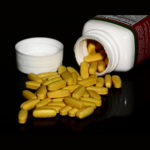By Ben Fuchs | Pharmacist Ben
Late last week the FDA approved a new drug to treat Pulmonary Arterial Hypertension (PAH). The medication, called macitentan (Opsumit, Actelion) is the second drug approved this month to treat the debilitating disease. Earlier, the regulatory body approved a medication called riociguat (Adempas).

Micrograph showing a plexiform lesion of the lung, as seen in irreversible pulmonary hypertension. Image contributed by Bulent Celasun, MD, via Wikimedia Commons.
Pulmonary Arterial Hypertension is a condition that affects the blood circulation in the pulmonary system, which is medical term referring to respiratory mechanics and the lungs. Although no one knows exactly how many people have PAH, according to the American Thoracic Society (ATS), it may affect as many as hundreds of thousands of Americans. It can best be thought of as high blood pressure of the lung arteries and can lead to all kinds of unpleasant bodily symptoms including bluish lips, hands or feet, dizziness, fatigue and lethargy, shortness of breath, fainting and swelling in the lower extremities. PAH has no surgical cure, progresses rapidly and is marked by progressive degeneration and breakdown of the blood vessels that travel from the heart to the lungs. In a normal healthy body, blood is carried from the heart, then to the lungs, where it picks up oxygen, which is then in turn delivered back to the heart and then to the rest of the organs and tissues of the body. Under conditions of Pulmonary Arterial Hypertension however, pulmonary arterial constriction, i.e. a tightening of the blood vessels in the lungs, restricts flow resulting in a sluggish circulation to the heart as well as a decrease in the amount of blood and oxygen that is ultimately delivered to the rest of the body. In addition, long term hypertension in the pulmonary arteries can lead to vascular changes including thickening of vessel walls, inflammation and the formation of plaques, all of which can further impair circulation and blood flow. Most significantly as the condition progresses, the heart, which is forced to work harder and faster to compensate for the vascular changes, becomes weakened. This can result in heart failure which is the most common cause of death in cases of PAH.
PAH can be associated with various other disease states including connective tissue disease, hypothyroidism, liver disease and heart disease, HIV infection and stimulant drug intake. However the vast majority of cases, according to ATS literature are said to be idiopathic, meaning they are associated with no known cause.
Although there is no medical cure for Pulmonary Arterial Hypertension, drug treatments have traditionally focused on vasodilators, which open up the blood vessels. However these kinds of drugs can create potential problems via lowering blood pressure in the rest of the body and ultimately decreasing the flow of blood to the lungs. Although the recently approved drugs, macitentan and riociguat, operate via novel mechanisms they are still vasodilators and can result in the same kind of problems as the more conventional PAH medications.
As with other circulatory health challenges there are many nutritional and dietary strategies that may help improve PAH. According to researchers writing in the European Respiratory Journal in April 2013, there is an increased prevalence of insulin resistance in PAH patients. Thus, restoring insulin sensitivity by reducing the intake of sugars and refined carbs may have a beneficial effect. Additionally there are nutritional supplements that can be used that improve insulin response. Niacin, thiamin, chromium and vanadium can all increase insulin sensitivity. So can the mineral magnesium, which can the potentize effects of insulin, and can provide lung and circulatory benefits. Magnesium has also been used as a medical treatment for PAH in newborns. In a 2004 study of 12 newborn babies with pulmonary hypertension published in the Journal of Tropical Pediatrics, magnesium was found to be “a safe and effective pulmonary vasodilator”, which is medical talk for “a safe substance for opening up blood vessels in the lungs”.
Finally, according to the University of Maryland Medical Center, while not specifically associated with treating pulmonary arterial hypertension, there are several nutritional supplements that can be used to improve heart health function in general. These include carnitine (500mg, three times a day), CoQ10 (200-600mg a day), Vitamin E (400 IU a day), potassium (20mg and day) and taurine (1000mg twice a day).














